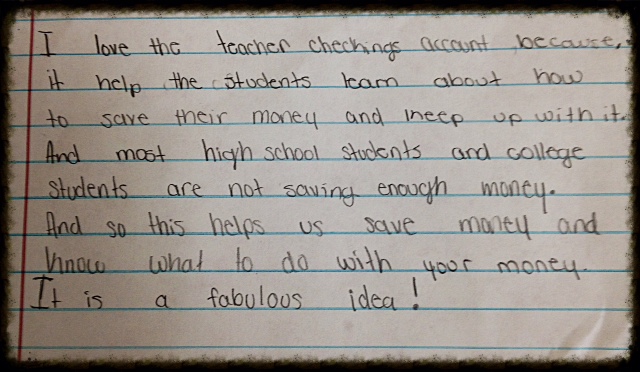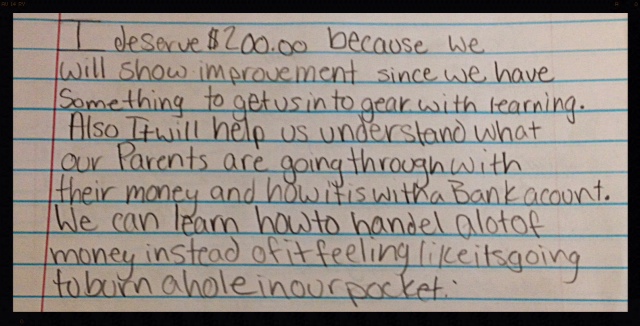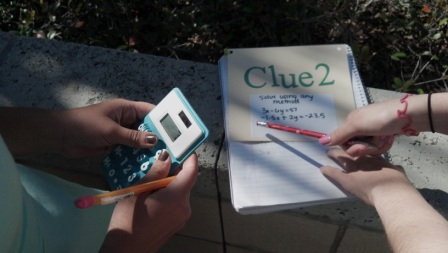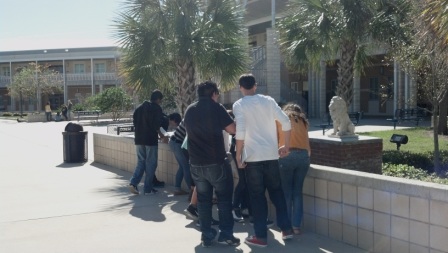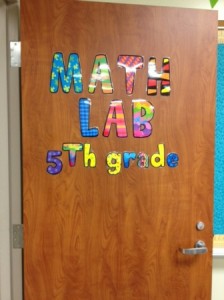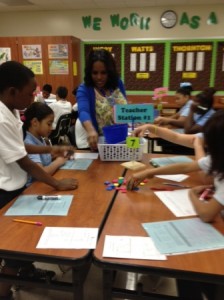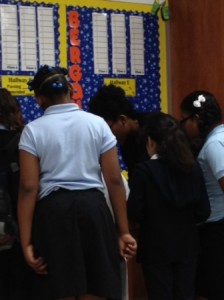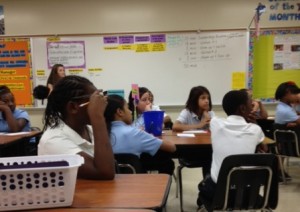Aha Moments and Tabor Rotation
An Aha Moment, according to the Merriam-Webster Dictionary, is a moment of sudden realization, inspiration, insight, recognition, or comprehension.
Aha moments can also be seen inside the brain. WebMD.com describes a scientific study in which researchers found an increased activity in a small part of the right lobe of the brain when the participants reported creative insight during problem solving. Little activity was detected in this area during non-insight solutions. http://men.webmd.com/news/20040413/scientists-explain-aha-moments
In a LinkedIn post by Daniel Goleman, “Maximize Your Aha Moment,” he describes the conditions whereby the gamma spike is more likely to occur. The pre-work for the gamma spike includes defining the problem, immersing yourself in it, and then letting it all go. It’s during the let-go period that the gamma spike is most likely to arise and along with that the “aha” or “light bulb over the head” moment. [http://www.linkedin.com/today/post/article/20130312165729-117825785-maximize-your-aha-moment]
Providing the conditions for aha moments is one of the goals of Tabor Rotation Institutes. Participants are immersed into the Framework from the moment they walk in the door and provided with “letting go times” to share throughout the day. One of the most meaningful times is sharing our aha moments as we bring closure to the day.
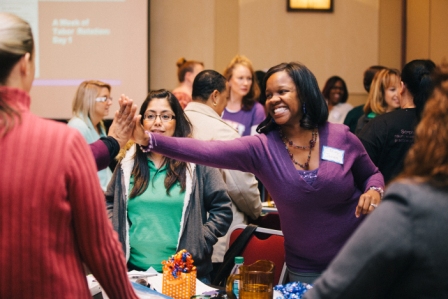
Here are a few aha moments that were recently shared at the end of a Tabor Rotation Institute:
-
With this framework, I can get everything taught and reach everyone.
-
You need to plan sooner than a week ahead.
-
You don’t have to start with all 5 days [of Tabor Rotation]. You can just work your way through it.
-
If every student has a team role, then everyone is important.
-
Seeing how to use the 6-Week’s, Long-Range Planner showed how all the pieces fit together and everything just flowed!
-
Always hold Leadership Academy—then you’re not the only one in the room who knows what to do!
-
Teach only what is needed to those who need it.
-
The on-level, average student rarely gets the attention they deserve and need!
-
Pull the above-level students as the first Readiness Group so you can challenge them.
-
Innovation…my students must become innovators!
-
If I use different clipboards during Clipboard Cruising, the students will know when I’m a process observer and when I’m going to stop and reteach.
-
Why ½ x ½ = ¼…who knew it would be so easy to understand using pattern blocks???
-
Algebra can be hands-on and makes sense with Algebra Tiles.
-
Learning to fail supports learning from experience.
-
Passports will keep individual accountability in the stations.
-
Team Names and Freeze Words should come from a list of the most important tested vocabulary terms.
-
Teach the most difficult concepts in Teacher Time.
-
Front loading is so much more productive than remediation.
-
Reflecting with my team—they were BRILLIANT!
-
It really is possible to get it all done in a way they understand!
In his article, Daniel Goleman describes “the physical marker we sometimes feel when we have a gamma spike or “aha” moment. It’s associated with pleasure and joy. He goes on to describe the fourth stage of “aha” moments…implementation, where a good idea will either sink or swim. He found that nurturing the creative insight is vital. When a person offers a novel idea, instead of the next person who speaks shooting it down—which happens all too often in organizational life—the next person who speaks must be an ‘angel’s advocate,” someone who says, ‘that’s a good idea and here’s why.” This should be what occurs in schools when teachers and principals have a novel idea that will help students…
I also like the definition (and all of the aha moments people share on her website) of an aha moment from Oprah.com
…a moment of clarity, a defining moment where you gain real wisdom-wisdom you can use to change your life. Whether big or small, funny or sad, they can be surprising and inspiring. Each one is unique, deeply personal, and worth sharing. http://www.oprah.com/packages/aha-moments.html
Watching “light bulbs” go off in the classroom, encouraging aha moments– that’s one of the reasons why teachers use Tabor Rotation. Not only does it give teachers a plan for meeting the needs of and helping every student reach their potential, but it also provides space for students to create, innovate, and think! Hopefully, along the way, teachers are busy having aha moments, too!
Increasing Scores via Financial Literacy
How can you increase scores on a state test by teaching financial literacy?
That was one of the questions asked by several teachers who were recently trained in M-Cubed: Meaningful Math Management. This resource is used nationwide to teach accountability and personal financial literacy at the same time. I created M-Cubed a couple of decades ago when trying to give my students a real-world application of math concepts.
After reviewing their pre-assessment on decimals, I knew I needed something that would grab their attention besides decimal rules. I sat in one of the desks in my room and tried to think like my students. When did decimals, computational proficiency, conversions, and percents become important to me? My first idea ended up being the students’ favorite one, too. It was my first checking account that was my first taste of using mathematical concepts in a real-world setting. Why not create one for them?
Now, back to the increase in scores.
How could using a pretend checking account help students’ scores increase? Here are just a few examples.
1. Students earn salaries for working hard and applying themselves in the classroom. Test Connection: It becomes habitual for students to work hard and apply themselves on everything that is done in the classroom. This includes tests. Plus, every time I gave a quiz or a test during the school year, and they used their repertoire, it earned them extra income. Every student worked hard because it was what you did.
2. Students begin to see the connections between what they studied in school and the real world. The more income they want, the more extra work they do, the more money they have to spend in the classroom store. Test Connection: The harder you work on a test, the better your score, the more you know about math, the more you can do with it to earn money in the real world. This is exactly what happens with the class checking accounts.
3. Students have to pay debits for not being prepared for class. Borrowing a pencil during class time costs 3 times as much as buying a pencil when the classroom store is open. And, you have to calculate the difference in cost correctly in order to borrow the pencil. Test: Students start coming to class prepared and begin to train themselves to buy pencils ahead of time, even if no one from home purchased one. This leads to them being more responsible with supplies, homework, and learning. The test scores go up as the amount in their bank account increases.
Before any student may open an account, the teacher requires them to write why they deserve the first $200 in their account and why having a checking account is a good idea. After reading the first few written by their students, teachers are always convinced it will be worth their efforts. But I’ll let you read for yourself…
I’m always surprised by one of the concerns that teachers have about using M-Cubed. They are concerned about the response from teachers who think that extrinsic motivation isn’t a good way to improve a student’s work habits or behavior. These teachers believe that students should do well in school because they have an intrinsic desire to do so.
How do you respond? I always ask this question.
“Do you come to work for free?”
Interestingly enough, the students in these classes were quick to tell me that they knew their teachers were paid to teach them, but they weren’t getting paid extra for creating a meaningful way for their students to learn concepts. They realize that their teacher’s intrinsic desire to do what is best for their students is the driving force for using M-Cubed. M-Cubed provides the extrinsic motivation to get students to “the table of learning.”
However, without intrinsically engaging and qualitatively challenging instruction that leads to competence, relatedness, and autonomy (Deci & Ryan, 1985; Ryan & Deci, 2000; Self-Determination Theory), M-Cubed is worthless. [Read more about the balance of intrinsic and extrinsic motivation.]
Because this management system is the perfect compliment to the Tabor Rotation Framework and is applicable at every age level, it’s available to anyone for free. (There’s even one to use at home and one to use with preschoolers.) A Slideshow Presentation explaining M-Cubed can be downloaded and/or watched from the FREE RESOURCES page.
Here are some of the components you might want to use as you implement this incredible management system with your classes: M-Cubed Checkbook Cover, M-Cubed Earned Income Spreadsheet, M-Cubed Checks, M-Cubed Debit and Credit Examples, and the M-Cubed Check Ledger.
Can learning about financial literacy increase scores? It has in every classroom where it’s been implemented. Why not try it with your students and see what happens!
Hands-On Algebra: A Scavenger Hunt
How do you engage students? How do you teach them to be innovative and creative? You think outside the box as a teacher. Recently, an Algebra I teacher sent me an email sharing an incredible task she created for her students. I was fascinated by her meaningfully application of the concepts she was teaching and asked her if I could share her task.
Algebra Scavenger Hunt
To make your own scavenger hunt:
- Make a map of your school on a coordinate plane.
- Hide clues in 8 different locations throughout the school. Each clue will have problems on them.
- Give each pair of students a system of equations problem. They will need to solve it, graph the solution on their map, and go to that location to find another problem. That problem will send them somewhere else in the school.
- Make play money to use as a “point” system. (For my money, I took one of those school pictures I never know what to do with and placed that on top of the money on the dollar sign. The kids really got a kick out of that!
- Give each group 5 dollars before they begin. Allow them to spend a dollar to get a hint from you if they need one. As they continue, they will either earn money (getting a question right) or lose money (making inappropriate choices such as disrupting another class or going somewhere on campus they should not have been.)
To create a system of equations from an order pair:
- Take the ordered pair you want to use as the solution of system of equations. I chose (12,8)
- Create the first part of both equations. For example, -2x+3y = _______ and 4x -3y = __________.
- Then need to plug in the x and y values to get what they equal. So using the same two equations from before I used -2(12)+3(8), -24+24 and got 0, so the first one is -2x+3y=0. Then the second one is 4(12)-3(8), 48-24 and you get 24 so that one is 4x-3y=24.
- Now you have a system of linear equations -2x+3y=0 and 4x -3y = 24 and have 7 more to make.
All of my prizes (except for the pencil) were things that I didn’t purchase. The students were very
excited about the grand prize, 100% on the unit quiz. After all, if they could just solve the four system of equation problems then they have already mastered the quiz. As a side note, very few groups asked for a hint and my systems were hard, too!
I’m so proud of my students! They worked very hard and had a good time!
Don’t you wish you had this teacher when you took Algebra? Don’t you wish your own children had an experience with Algebraic concepts like this? I think Lisa Nielsen [Visit Lisa’s blog for more innovative ideas and thoughts.] had the best quote, from Will Richardson, in one of her posts,
“What I want from my kids’ school is to help me identify what they love, what their strengths are, and then help them create their own paths to mastery of their passions. Stop spending so much time focusing on subjects or courses that ‘they need for college’ but don’t interest them in the least. Help them become learners who will be able to find and make good use of the knowledge that they need when they need it, whether that means finding an answer online or taking a college course to deepen their understanding. And finally, prepare them to create their own credentials that will powerfully display their capabilities, passions and potentials.” [More from Will Richardson]
Download copies of the description of the Scavenger Hunt Store and Directions for the Scavenger Hunt.
Thank you, Kari, for sharing this incredible task!
Side Note: This teacher uses small-group differentiated instruction in her classroom on a regular basis using the Tabor Rotation Framework and engages her students like this on a weekly basis. AMAZING!!!
More Questions, PLEASE!
??????????????
A friend recently shared with me her winter break experience taking her daughter to a hands-on museum. She said they spent six hours at the museum. She really wanted to share the questions her daughter was asking as she was interacting with the hands-on exhibits. She shared all of them with me because she knows how important questioning is in a classroom.
“What would happen if we redid it like this? Can we try and see?”
“Would that airplane go higher if we built it in a rocket shape? What is that shape called?”
“How many pulleys does it take to lift me up? What about you? Daddy’s not here, so how can we figure out how many pulleys to lift him up if we know how many for me?”
“What would make my car go faster? Hmmm…can I try a different way?”
“Look Mommy, the pieces to the road can only be put together in one way. Isn’t that part of a fact family?”
Questions were literally flowing out of every child in the museum. In fact, there is a constant buzz in the museum from the excitement of wanting to learn. They weren’t completing a worksheet or looking at a picture…they were doing something with the knowledge and gaining more knowledge as they proceeded.
This list of questions arrived in my inbox with perfect timing. I was rereading Chapter 5 of Tony Wagner’s book, Creating Innovators:The Making of Young People Who Will Change the World. The chapter is entitled, “Innovating Learning” and I had just finished watching an incredible clip that featured Amanda Alonzo, a highly successful science teacher who emphasizes the importance of discovery and questioning with her students. [Click here for more about this INCREDIBLE book.]
Why write a blog about questions? I’ll let an expert explain…in that same chapter, Tony Wagner states,
“One problem with this traditional approach to learning, however, is that the way in which academic content is taught is often stultifying: It is too often merely a process of transferring information through rote memorization, with few opportunities for students to ask questions or discover things on their own—the essential practices of innovation. As a result, students’ inherit curiosity is often undermined and ‘schooled out’ of them, as Sir Ken Robinson and others have written.” [This TED talk by Sir Ken Robinson explains more and is well worth your time!]
Curiosity is nothing new. Throughout time, so many have attributed their creations, explorations, and inventions to questioning. When asked why he was able to develop so many theories and think the way he did, Albert Einstein repeatedly stated,
“I have no special talents, I am only passionately curious.”
In Simon Sinek’s book, Start with Why, he describes the dichotomy between Samuel Langley and the Wright brothers. Langley had the funding, the resources, and everyone thought he would be the first to fly—including Langley himself. The Wright brothers had no money, few resources, but they had such a passion to fly that they inspired the enthusiasm and commitment of a dedicated group in their hometown. This group banded together in the basement of a bicycle shop and made their vision real. Did they have questions? Did they expect to fail and fail often? Yes, but they also expected to fly. (Personally, I love the fact that the Wright team always took 5 sets of parts with them to every flying test or trial. I share this with my students to encourage them to try and try and try–and bring extra parts!)
My friend’s last question to me made me think the most,
“After watching all these children all day long, it just makes me ask…why aren’t we teaching this way in schools?”
No time like the present to begin. Here are a few simple ideas to help you begin:
- Put up an “I Wonder” chart on the wall of your classroom. Whenever a student simply “wonders” about something, have them write it on a sticky note and put it on the chart. Once a week, select a question from the “I Wonder” chart and develop a plan for finding the answer.
- Bring in an old box and label it “The Question Box.” If a student has a sincere question, they drop it in the box. Questions are pulled out at the end of every class period. If no one knows the answer, then everyone goes home to “wonder” about it and share what they discovered with their partner the next day in class.
- Use Exit Questions at the end of every activity. Have students think about what they learned and how the information could be used in their world.
I’ll let Amanda Alonzo, whose students regularly finish among the 40 finalists in the Intel science competition, finish this post,
“To be a successful science teacher, you have to make it fun, and for kids that means making it theirs—so that they have ownership over what they are learning. It’s what motivates them…The most important thing is allowing students to ask questions and then giving them the space to find the answers.”
Common Core & Personal Financial Literacy
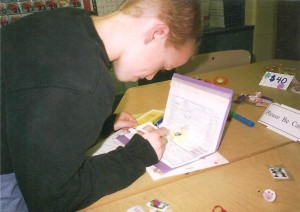 A math teacher at a recent Tabor Rotation training session came up during the break and began sharing her frustration with me,
A math teacher at a recent Tabor Rotation training session came up during the break and began sharing her frustration with me,
“I’m just learning the CCSS (Common Core State Standards) that our state recently adopted. Now our district is mandating small group instruction, math workstations, and regular intervention.
The latest? They’ve decided that the math department needs to fix the economy by incorporating personal financial literacy into the curriculum. I may even have to teach financial literacy next year. Of course, they want me to make sure that every student passes the end-of-course exams, too.
I’m sorry my students can’t balance a checkbook, but I only have 60 minutes or less in a class period. How am I supposed to do all of it?”
Over a decade ago, Lewis Mandell, Dean of the UB School of Management, made a similar poignant statement in his Final Word Editorial. The title of his piece sums it up, “Why Johnny Can’t Balance a Checkbook.” Mandell wrote that,
“Millions of American teenagers graduate from high school every year without a basic understanding of how to manage their money. As they venture out from under their parents’ protection for the first time, what awaits these young adults is an increasingly complex society that asks that they make immediate and sometimes irreversible financial decisions- decisions that will likely impact their livelihoods for years to come. Unprepared by teachers or parents to make those decisions, the consequences can be quite severe.”
After sharing some of the content of the articles linked to this blog post, I shared news from other states who are designing and requiring year-long financial literacy courses. Virginia is one of them. Vivian Paige says that a course in economics and financial literacy was a long time in coming and has been greatly needed by students who graduate not even understanding what a mortgage is and how credit cards calculate interest. Her brief article is worth the read.
As the discussion continued, I assured this teacher that Common Core was actually going to be an incredible tool for helping her and her students accomplish the goals set out by their district. I also assured her that putting a structure or framework in her classroom that would assist her students in becoming mathematically proficient would provide for complete exploration and in-depth understanding of the CCSS, a great passing rate on the EOC exams, and address personal financial literacy. In fact, I told her she was in the right session to find some answers. All she had to do was hang in there for the second half to learn how Tabor Rotation, Common Core State Standards, and Meaningful Math Management would fit together beautifully.
As she shared her concern about teaching personal financial literacy with the entire group, many other participants shared the same concerns. Wanting the financial crisis to remain in the past, many states are looking at what they can do to facilitate financial literacy. The state of Maryland, who was one of the first states to adopt Common Core State Standards in June, 2010, has sought to write their own financial literacy standards since these are not specifically written in Common Core.
“Today’s students need a strong foundation in personal finance to help them budget and manage their money. Many students work during high school; some even have credit cards in their own names. After high school, young people often make uninformed decisions that can negatively impact their credit ratings and their ability to gain security clearance for employment. With the nation currently in the midst of a financial crisis, far too many people are deeply in debt and are faced with the reality of losing their homes and their financial security…the state curriculum lays the foundation for a new generation of competent, confident, and financially literate adults.”
Other teachers were concerned about the fact that Common Core asks teachers and districts to find a balance for mathematical content in the combination of procedures and understanding. The next statement,
“There aren’t any personal financial literacy standards in Common Core. They want us to find ways to combine math standards with social studies and reading/English language arts standards.”
Yes, I told them, that’s true, but the clustering of the CCSS is an amazing way to make learning meaningful. Even Tony Wagner, author of Creating Innovators: The Making of Young People Who Will Change the World, would probably agree that clustering standards from different disciplines is a way to encourage students to find purpose and passion about what they are learning. This has been of great concern to Georgia as well. The Georgia Performance Standards Mathematics Curriculum, mirrored in the CCSS, is designed to achieve a balance and a connection among the disciplines and emphasizes rigor and relevance.
“The Georgia Performance Standards Mathematics curriculum is designed to achieve a balance among concepts, skills, and problem solving. The curriculum stresses rigorous concept development, presents realistic and relevant tasks, and maintains a strong emphasis on computational and procedural skills. At all grades, the curriculum encourages students to reason mathematically, to evaluate mathematical arguments both formally and informally, to use the language of mathematics to communicate ideas and information precisely, and to make connections among mathematical topics and to other disciplines.”
I shared that the state of Pennsylvania is asking their state department of education to develop cross-curricular materials that would take the Common Core Standards for Math and incorporate the state’s academic standards in arts and humanities with the Common Core Standards for ELA to help develop financial literacy skills.
At this point, the body language in the room indicated they had had enough of the facts and wanted more–a plan that would work. We had explored The Tabor Rotation Framework for several hours, but they wanted to know about the connection or clustering for financial literacy. I shared Meaningful Math Management with them. Meaningful Math Management was an instructional tool I created at the same time as Tabor Rotation. It was developed as an answer to cultivating classroom communities with my students, providing real-world application of math concepts while teaching financial literacy and personal accountability. All of the information is available on the FREE RESOURCES page of my website. There is a slide presentation and all of the materials you need to put this incredible structure into place in your classroom. But, rather than explain it to you myself, I’d like to share a teacher’s experience that she sent to me in a recent email.
“One of the most exciting ideas we gained from the Tabor Rotation workshop in June was the management system. For years we had complained about our students being irresponsible with their work, supplies, and behavior. Using manipulatives was such a disaster that we seldom used them, knowing the importance but not willing to deal with the chaos. Many students didn’t have pencils so time was wasted as they borrowed or teachers furnished them. Neither solution was acceptable and only facilitated dependency. Obviously, you can’t do math without pencils, at least with all the paperwork we did before Tabor Rotation. Every six weeks we agonized over all the students who had missing work, newsletters that weren’t returned signed by parents, behavior problems, lack of supplies, etc.
The change in all these areas has been phenomenal since using the Meaningful Math Management system. Students are caring for their supplies and responsible for purchasing pencils rather than borrowing, which really means taking. Just the stress and time involved in this alone has been unbelievable. It may seem like we’re overstating this, but believe me we are not. As the math inclusion teacher, I volunteered to oversee the store. Students can buy supplies and snacks from me between classes or before school. If they go to class without necessary supplies, the teachers sell pencils at double the price.
Using this system is what makes the rotation stations manageable. The students have their jobs and are rewarded for working together as a group appropriately. I especially love the emphasis on positive behavior. It’s a big change in mindset for our grade level from the past system of giving marks for misbehavior. After a few negative responses, that system becomes ineffective. As Glenna demonstrates in the workshop, a positive response, such as “every one at that table gets $5 for….” makes an immediate improvement in the entire room’s behavior. This is exactly what I learned in my classes 38 years ago at TWU. Unfortunately, it’s much easier for us to respond negatively, but research has proven that behavior improves more effectively from positive reinforcement than negative.
Learning to write checks, balance check registers, and make spending decisions is providing a lifelong benefit. If students do need to pay a fine and have no funds, they go to our assistant principal. Rather than receiving a punishment, he discusses the value of money management and doing what is necessary to earn money rather than paying fines.
Because of students managing themselves, using Tabor Rotation has made for much happier students who are enjoying math rather than dreading it. In the past we have bombarded them with worksheets, which also caused stress from grading and pleading for missing work. Now, we have fewer worksheets but are using them more effectively with more direct teacher interaction. I actually heard two students today say, “I love math! Yes, it’s work, but Meaningful Math Management is worth it!”
As Vivian Paige said,
“And we expect everyone to save for their own retirement, use credit wisely and manage their money. How do we get there from here?”
Simple—create the perfect storm in your classroom.
Common Core State Standards + Tabor Rotation + Meaningful Math Management
Tabor Rotation in a Math Lab
“If I had thought about it, I wouldn’t have done the experiment. The literature was full of examples that said you can’t do this.” -Spencer Silver (inventor of Post-it adhesive)
People typically don’t read long blogs. But, this one is well worth the read! A few weeks ago, I had the incredible opportunity to visit a school who took a team of teachers who have used the Tabor Rotation Framework for a semester, a couple of available classrooms, an enthusiastic math specialist, a supportive administrative team, a little bit of time, a little bit of sweat, and…created a Math Lab!
Their information is worth thinking about and trying, so the formula for this blog post is simple. If one picture is worth a thousand words, then the pictures that follow should offer exactly what you need to get you started in putting a math lab in your school. This blog post may be longer in length, but keep scrolling down!
Approximately 3-4 weeks in advance, teachers plan for the content of a week using Tabor Rotation. They base their plans on Pre-Assessments and on-going assessment via Clipboard Cruising. This Planning for Tabor Rotation Sheet is an example of what they use to assist them in long-range planning.
While the rest of the class is working on exercises in computational proficiency and basic fact memorization, the teacher holds a Leadership Academy, with the Leaders and Co-Leaders of each team, at the back of the room. The Leadership Academy is the time when the teacher reviews how to complete the activities at the Games and Manipulative Stations. These activities have also been a part of the Whole-Group Mini-Lessons on Days 1 & 2 of Tabor Rotation, so this is a review and check for understanding with the leaders and co-leaders.
Not only do the Leaders and Co-Leaders have an important job in facilitating the learning taking place at the stations and keeping their teams on task, but Team Roles are given to every student so that each person is a vital and contributing member of the learning community.
The students work with partners as the teacher continues the session in the math lab with the Whole-Group Mini-Lesson. This Mini-Lesson is conducted with the entire class who is sitting next to their assigned partners. The teacher will pause every 3-5 minutes to encourage students to talk to their partner. This regular, planned Simultaneous Interaction helps students understand concepts and place them into short-term memory. It’s also extremely helpful as students share with each other and make connections to the concepts being explored.
The teachers at this school vary the modalities through which students learn concepts by having students rotate through the 4 Tabor Rotation Stations. They have arranged their desks in clusters to provide for as many as 36 students at a time in the lab. They even shared a copy of their Room Design and Rotation Plan in case you want to use it.
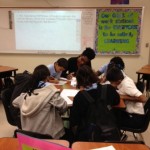
Teacher Time: The station that gives the teacher an amazing opportunity to work with ¼ of the class on the most difficult concepts for the week instead of trying to explain the most difficult concepts to the entire class at all at once.
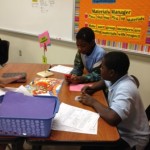
Games: The station in which students interact in a fun, competitive, and challenging medium to practice concepts.
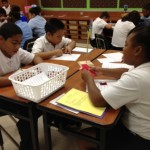
Manipulatives: The station that gives students a chance to explore and understand a concept concretely.
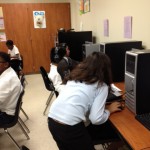
Technology: Computers and a Mimeo White Board help students practice a previously learned concept for intermittent reinforcement.
Some of you might be saying, “That sounds great, but how do I manage this type of instructional structure in my classroom or in a math lab?” This school has many Classroom Management tools to assist their students in being successful in learning math in a meaningful way.

Every station has a leader folder with detailed directions on how to complete the activity, work the technology, or play the game.

Exit Questions, checks for understanding, and journal writing are a part of the Passport given to each student to take with them to every station. This is also a great tool for individual accountability.
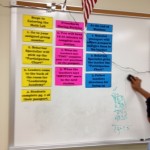
Just as science labs have specific rules for handling experiments and equipment, so do math labs.

Signs with directions on where to move next really help the transition from station to station—especially when larger classes require two groups, or tables, at each station.
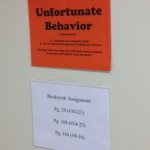
I can’t imagine a student not wanting to participate in the excitement and activity in a math lab, but if inappropriate behavior occurs, students are sent to complete boring worksheets at the Unfortunate Behavior Table.
The hum of productivity was everywhere in these labs and back in the classrooms as they continued doing what is best for all their students through Readiness Grouping on Days 4 & 5 of the Tabor Rotation Framework. That week, the teachers were sophisticating their use of Clipboard Cruising to provide for on-going assessment and to help them form the varied levels of readiness groups in their classroom. You might find this Tabor Rotation Readiness Grouping Spreadsheet useful as you plan for readiness groups in your classroom, too.
As we all know, every good team has an incredible coach and a spark plug to ignite us and inspire us. In the background, helping with the stations, you might be able to spot an additional adult in the room–she’s the math specialist for the school. When people visit to “see what has caused this school’s results to rise to the top in their district,” her roll is often misunderstood. Most have thought that the teachers bring their students to her and she does the rest. As she explains it, “this wouldn’t be optimizing the teacher capacity in our school.” Her true role is helping guide the team of teachers and the classes of students who use the math lab. She also facilitates the planning for Tabor Rotation, based upon regular pre-assessments, at least 3-4 weeks in advance. Attached is her job description as the Math Specialist.
As Agnes de Mille said, “The artist never entirely knows. We guess. We may be wrong, but we take leap after leap in the dark.”
Experiments and scientific labs have sparked imagination, curiosity, and amazing discoveries that have changed our world forever. Math labs have the potential to do the same thing. But, they are different than the traditional math classroom and trying them may feel like you’re taking a leap into the dark. A big THANK YOU to Marcella Intermediate for sharing their story and for lighting the way for others to take that “leap” into using math labs!
Questions about Tabor Rotation
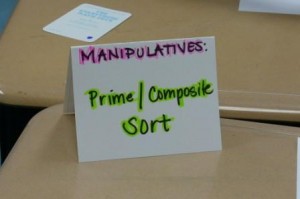
Questions, questions, questions…I LOVE them! Why? I love questions from administrators and teachers, because if no one asks a question, then it’s highly unlikely that they will use the information. Tony Robbins says,
“Successful people ask better questions, and as a result, they get better answers.”
When someone asks a question, then I know they are “hooking” it to what they already know and do and are thinking about how they will use the information in their own classroom or school. The next few blog posts will be dedicated to answering some of the questions asked at trainings this summer.
How often do you change leaders and co-leaders?
I set a goal for changing the Team Roles at least once a month or once a quarter. I found that changing them once a week was too confusing to everyone and didn’t give the students a chance to learn and develop from the responsibility of their role. However, some classes are a bit more volatile than others and have difficulty with change. One of my classes, with whom Tabor Rotation began, had challenges working in groups and following directions. Once I got the mix of the teams right and the team roles right, I didn’t change them again all year!
How does the 5E Lesson Model correlate with Tabor Rotation?
Engage- Engagement is seen throughout The Tabor Rotation Framework, but can easily be seen during Day 1 of Tabor Rotation’s Overview for the week and every day during the Whole Group Mini-Lesson.
Explore- Exploration should occur every day during the Whole Group Mini-Lesson, which typically include manipulatives and working with a partner to explore new concepts. And, The Manipulative Station, where the concrete exploration of concepts is the emphasis.
Explain- Explanation can be done every day during the Whole Group Mini-Lesson and during the Readiness Grouping on Days 4 and 5 of a week of Tabor Rotation. However, the framework emphasizes how the teacher meets with ¼ of the class at a time in Teacher Time Station to explain the most difficult concepts for the week.
Elaborate- The Technology/Innovation/Application Station is one place where students are elaborating on the concepts they are learning. The students are also elaborating when they are working independently or with a partner on the menu of options on Days 4 & 5 when the teacher is meeting with Readiness Groups.
Evaluate- Several of The 14 Essential Elements are based in evaluation. The teacher must choose some method for constant, on-going observation and evaluation. This is called Clipboard Cruising. This information is used to form Readiness Groups for Days 4 & 5 and is shared with the students. Exit Questions and Passports are used at every station of Days 2 & 3. These help the students reflect and evaluate their understanding of the concepts being explored.
How would you connect the activities in the Manipulative and Games Station to the concepts they are supposed to be understanding?
It is always a relief to be asked this question. It means that participants are thinking about the Tabor Rotation Stations in the right way! Helping students connect the activity or game in which they were just involved is imperative. Every student needs to know what concepts they were learning and why. Making sure that Exit Questions are asked at the end of each rotation is one way of making sure the connection is made. A sample of these questions can be found on the FREE RESOURCES page of this site.
Reviewing and clarifying the content of The Teacher Time Station during Thursday’s Whole-Group Mini-Lesson is another opportunity to bridge activities and games with the concepts being learned and apply them in different situations. Of course the content of Readiness Groups could always include this same connection, reflection, and clarification.
Do you consider drawing a form of manipulative?
Another great question as teachers compile materials and resources to use with activities in the Tabor Rotation Stations. Drawing is typically included in the Passport or Evaluation at the end of the station time. This helps students move from the concrete to the pictorial stage of understanding a concept. For more information about the types of pictures used to bridge from the concrete to the abstract, you may want to read an article by Hartshorn and Boren. It’s a few years old, but has a really good explanation.
The Tabor Rotation Manipulatives Station emphasizes that the content must be the concrete conceptual development of a concept. Manipulatives used might be tiles, cubes, geoboards, dice, counters, buttons, money, lids, algebra tiles, cubes, or any item a student can hold and manipulate while developing an understanding.
The Manipulatives Station criteria were very important when the four stations were initially developed. Since the state assessment was performance based, using manipulatives helped the instruction become more performance based. You can read more about the origins of Tabor Rotation in a previous blog.
I always enjoy this quote from the article by Hartshorn and Boren,
“The reasons that teachers do not use manipulatives are beyond the scope of this Digest.”
Do you allow groups to track their points? If so, how do you keep them honest about the giving of points?
Yes, I encourage the teams to keep track of their own points. This may be accomplished in several ways. You could use the Team Point Sheet and have the Timekeeper record the points at the end of each class period. Some teachers post a bar graph and have Timekeepers fill in the next amount on the graph. This allows students to record and compare data that is meaningful to them.
How do I keep them honest? I use the Meaningful Math Management System with my classes. All the resources you need to use this system are available on the FREE RESOURCES page of this site under the Meaningful Math Management heading. To even open up an account with me, they have to sign a contract and give me their word that they will be honest. If they are caught being dishonest, I pull out the contract and we review their agreement. I found that trusting them and placing the responsibility on their shoulders brought about more hard work and honesty than if I’d been keeping track of every point. (Plus, it’s exhausting!)
How many state standards should be introduced each week?
Take a look at the explanation of “How do I teach all the concepts I need to teach?” This document has proven to be really helpful to teachers beginning at the intermediate level.
What is the time limit for each activity at the middle or high school level?
This Time Line for Middle School and High School might be helpful. The Tabor Rotation Training Guide is a great resource when determining time frames. Chapters 15-17 explain each of the types of days in a week of Tabor Rotation. Chapter 19 is about how to plan for a week of Tabor Rotation.
I’d like to end with what was written on the last sticky note I pulled off the workshop’s “Parking Lot.”
“I’m already stoked about your platform…talk about useful!”
Thanks for the questions and the inspiration! On to Coldspring, Texas for more!
The Origin of Tabor Rotation
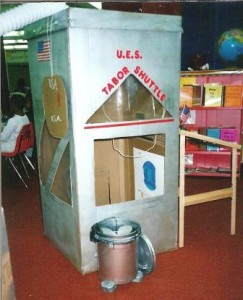
Like any good invention, the Tabor Rotation Framework came out of necessity. A couple of decades ago, I realized that my students needed a better way to learn mathematical concepts. I had almost 40 students in a class, a classroom with no walls, fewer than half of my students on grade level, less than 60 minutes to teach math, and my students would be taking MSPAP (Maryland School Performance Assessment Program). The way I had always taught math wasn’t going to be effective for much longer.
I probably need to digress at this point and explain a little about MSPAP. (This blog may be a bit longer than usual, but to understand why new state assessments like STAAR don’t scare me or teachers who use Tabor Rotation, you have to understand the level of complexity and challenge of Maryland’s performance-based test.) MSPAP was the first and only state test to use a “matrix-sampled design.” This design was a measured format in which a large set of tasks were organized into a number of relatively smaller sets or forms which were randomly assigned to test takers so that no students responded to all of the items. The test consisted of three similar sets or forms, each containing one-third of the total test. Because a given student answered only 1/3 of the questions, scores were aggregated for schools and districts for program evaluation and school improvement.
MSPAP also had other unique features:
- Students took the test for 2.5 hours per day for five weeks days.
- Students had the option to respond to tasks by drawing, graphing, or writing.
- Students worked in small groups to conduct short experiments and used the data collected as a basis for their answers
- The test was composed of theme-based tasks that consisted of only constructed response items that integrated measurement of reading, language usage, writing, mathematics, science, and social studies.
- The test engaged students in “real world” scenarios to assess students’ ability to apply higher order thinking skills and processes.
- In order to mirror the assessment, teachers had to teach in a real-world, performance-based way, and emphasize innovation instead of regurgitation.
Most of the teachers with whom I worked hated MSPAP (I was going to use the word dislike, yet hate truly sums up how they felt), but I thought its design encouraged more effective teaching and learning, so I embraced it. (Okay, those same colleagues would tell you that another parenthetical statement is needed here..I was a little bit obsessed and created performance tasks as a hobby, but teaching and learning this way truly fascinated me!) Schools didn’t know what the experiment was going to be since they didn’t receive the materials for their MSPAP experiments until 3 weeks before the test. Teachers didn’t know which portion of the test each student would take and student responses could be divergent. So, schools and teachers couldn’t “teach to the test.” Instead, they had to base their instruction on state and national standards and teach students to think using their skills and processes in any given situation. Sounds kind of like real life instead of a state test, huh?
My passion for teaching this way and my desire to learn as much as I could to help my students led me to working with ASCD. The Association for Supervision and Curriculum Development was bringing in experts to help Maryland teachers. That’s how I ended up meeting and working with Robert Marzano, Jay McTighe, Deborah Pickering, John Brown, and Cerylle Moffett. All of these theorists were conducting research in Maryland because of its state-wide assessment that was performance-based instead of criterion-based. The practitioners, or teachers, who were making sense of Marzano’s and others’ theories, were encouraged to think outside the box doing things like Tabor Rotation.
In fact, my class and I were featured in a national teleconference on “Performance-Based Assessment Using the Dimensions of Learning Model” with Bob Marzano. The students’ guided tour of the Space Station they designed, built, and manned was part of that teleconference. This clip shows how effectively engaged an extremely large class was in instruction that was meaningful, challenging, and encouraged innovation. I’ll blog later about what cultivates innovation in a classroom, but if you’d like to get a jump start, read Tony Wagner’s book, Creating Innovators: The Making of Young People Who Will Change the World. I believed then, and I believe now that these students are changing the world! [vimeo]http://www.vimeo.com/45767393[/vimeo]The clip clearly reflects the type of instruction being used and the students’ true ownership of the information. The unit of study integrated math, science, writing, language usage, reading, and social studies in a way that Bob was recommending to teachers all over the country. (He still is–read more about Classroom Instruction that Works.)
Teachers who use PBL (Project-Based Learning) and were wondering if Tabor Rotation and PBL were a good fit should be breathing easier at this point. The Tabor Rotation Framework was created to facilitate in-depth study of mathematical concepts in a meaningful way and also to provide for a venue for real-world projects that drive the students to have passion and purpose for the information they are learning.
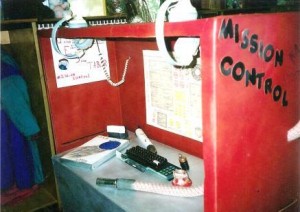
Now, back to finish the origin of Tabor Rotation…since MSPAP was fully integrated, performance-based, and relied on students’ ability to think critically and creatively, my math instruction was going to have to become more rigorous. That’s when I began to review everything I knew about balanced literacy, small-group instruction, differentiated instruction, critical and creative thinking processes, meaningful application of knowledge, project-based learning, and good, effective teaching strategies. I studied how the brain learns and how students learn best in a classroom. The first few years of Tabor Rotation were a testing ground for essential elements. Mixed grouping at stations, leadership academy, and mathematician’s circle came first. After the first school-wide implementation of Tabor Rotation the scores increased by over 32% in one year—I knew I was on the right track!
Over the next decade, the 14 Essential Elements were identified, implemented, tested, and have continually proven to be essential and effective. Along with the implementation of essential elements, teachers, grade-level teams, and schools piloted versions of the weekly planning guide to make planning for Tabor Rotation simple and user-friendly. The Planning for Readiness Grouping sheet soon became a non-negotiable component to ensure that teachers were using on-going assessment and meeting with all students in readiness groups. Long-range planning guides, phases of implementation, and other templates have been added to assist teachers in small-group, differentiated instruction. Everywhere Tabor Rotation has been implemented, scores go up, students and teachers are changed, and math becomes more meaningful.
Now you know a little bit about the origin of Tabor Rotation. The Tabor Rotation Framework is simply a platform which provides a way for implementing all the things a teacher should already be doing. It reinforces the best practices and gives teachers a concrete way to help every student reach & exceed their potential. Tabor Rotation is a perfect plan for Tier I of Response to Intervention and for implementing small-group instruction in classrooms from pre-K to 12th grade.
Tabor Rotation varies the modality through which students learn concepts. It provides for smaller student-teacher ratio for instructing every student in the room. Tabor Rotation asks teachers to create a continuum of conceptual understanding which provides learning experiences for all students to move “a little bit further than they were the day before.”
Committed educators know they should do what is best for all students…I’m just an educator who figured out a plan that can help them do it and I like sharing it…
[vimeo]http://www.vimeo.com/37837180[/vimeo]
What is the difference between TAKS and STAAR?
“What is the difference between TAKS and STAAR?”
During the last year, this question has been voiced by parents during every one of my community group presentations. Last week, I promised one group I would blog about this question so they could better understand what was happening in Texas schools and to their children.
Maybe we should start off by answering a couple of basic questions. The Arlington ISD website offers some succinct answers,
“What is STAAR?”
The State of Texas Assessments of Academic Readiness, or STAAR, will replace the Texas Assessment of Knowledge and Skills (TAKS) program beginning in spring 2012. The STAAR program at grades 3–8 will assess the same grades and subjects as are assessed on TAKS. For high school, general subject-area TAKS tests will be replaced with twelve STAAR end-of-course (EOC) assessments.
“Why is there a new assessment program for Texas students?”
The Texas Education Agency (TEA), in collaboration with the Texas Higher Education Coordinating Board (THECB) and Texas educators, is developing a new assessment system in response to requirements set forth by the 80th and 81st Texas legislatures. This new system will focus on increasing postsecondary readiness of graduating high school students and helping to ensure that Texas students are competitive with other students both nationally and internationally.
If you’d like to read the responses to about 45 typical questions about STAAR, the AISD website would be worth your time. [http://www.aisd.net/aisd/Default.aspx?alias=www.aisd.net/aisd/testing]
Here is a simple explanation of the difference between TAKS and STAAR, as shared by the Texas Education Agency (TEA):
“TEA is also implementing a number of changes [in state-wide, mandated, student assessment] that should serve to test knowledge and skills in a deeper way.”
- Tests will contain a greater number of items that have a higher cognitive complexity level.
- Items will be developed to more closely match the cognitive complexity level evident in the TEKS (Texas Essential Knowledge and Skills).
- In reading, greater emphasis will be given to critical analysis than to literal understanding.
- In writing, students will be required to write two essays rather than one.
- In social studies, science, and mathematics, process skills will be assessed in context, not in isolation, which will allow for a more integrated and authentic assessment of these content areas.
- In science and mathematics, the number of open-ended (griddable) items will increase to allow students more opportunity to derive an answer independently.
- Students who are currently in 9th grade will be the first to take the End-of-Course (EOC) tests
- Under the new EOC system, students will be required to pass 15 EOC exams in order to graduate
- Test scores on each of the required EOC exams will count for 15% of the student’s final grade in the course.
- The last TAKS-based accountability ratings were issued in 2011. Accountability ratings will be suspended in 2012. The new state rating system will debut in 2013.
The North East ISD website gives a good description of what’s different about STAAR,
“The STAAR tests will be more rigorous than the TAKS tests and are designed to measure a student’s college and career readiness, starting in elementary school. These readiness standards will be defined by those TEKS considered critical for success in the current grade/course and important for preparedness in following grades/courses, and ultimately for college and career. The majority of the test (60-65 percent) will concentrate on these readiness standards, but STAAR will also assess other TEKS for the current grade/course — known as supporting standards.” [http://www.neisd.net/staar/general-info.html]
If you have more questions or would like to dig a little deeper about Texas’ new student assessment, the following links might be helpful.
http://www.tea.state.tx.us/student.assessment/staar/
http://www.tea.state.tx.us/index3.aspx?id=3302&menu_id3=793
As I speak to parent and teacher groups about STAAR and state-wide, mandated student assessments, I also share with them my lack of fear and reaction to any new state test. One teacher recently asked, “Will STAAR impact your work with Tabor Rotation?” That question and an explanation of the acronym, MSPAP, will be answered in my next blog.
“Much of the learning in traditional systems of imposed instruction is for the purpose of passing the next test. Information is put into the brain’s”closed file” as soon as the test is over because it has already served its purpose.” Lynn Stoddard
“Education is not preparation for life; education is life itself.” -John Dewey




